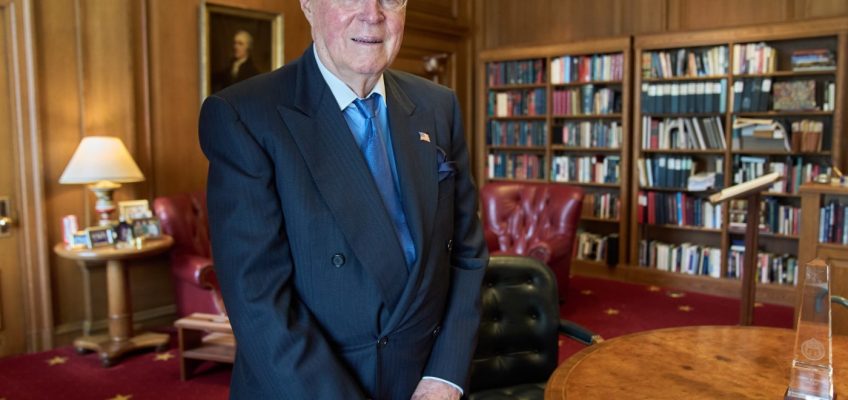Daniel Rosen will serve as the next U.S. Attorney of the District of Minnesota and comes to the post as authorities are investigating a number of fraud cases in the state involving millions of dollars.
Daniel Rosen will be Minnesota’s U.S. Attorney after his nomination by President Donald Trump and confirmation by the U.S. Senate on Oct. 7, 2025. (Courtesy of the University of Minnesota)
Rosen was one of more than 100 of President Donald Trump’s appointees confirmed by the Republican-majority Senate in a vote on Tuesday. The Senate voted on party lines to confirm Rosen, fill ambassadorships and appoint administrators to various federal agencies.
Republicans changed Senate rules last month to allow approval of Trump appointees in groups. The move came as Republicans grew frustrated with Democrats for blocking Trump nominees.
Rosen, however, received bipartisan support when Trump nominated him for the position in May. Earlier this year, U.S. Sen. Amy Klobuchar and U.S. Sen. Tina Smith, both Democrats, gave Rosen a “blue slip,” or signal of support. But they did not back Rosen’s confirmation in Tuesday.
“Daniel Rosen was one of over 100 nominees put forth as a block,” a Smith spokesperson said in a statement. “Senator Smith voted no on this group because she’s concerned too many Trump nominees put loyalty to him ahead of service to the American people. She hopes Rosen proves different and serves all Minnesotans with fairness.”
Minnesota Republican U.S. Rep. Tom Emmer praised Rosen’s confirmation in a Tuesday news release, describing Rosen as a “distinguished attorney with an unwavering commitment to public safety.”
“We are confident that Mr. Rosen will fight to protect Minnesotans, and their hard-earned tax dollars, from the scourge of crime and fraud we’ve seen in our state,” said Emmer, the third-highest-ranking Republican in the House. “We were proud to support Dan and thank our colleagues in the Senate for advancing his nomination.”
Rosen has more than 30 years of experience as a commercial litigator at the federal and state levels, according to the University of Minnesota Law School. Rosen graduated from the UMN law school in 1994.
Rosen, a U.S. Navy officer who served in the first Gulf War, also served on the Minnesota Campaign Finance and Public Disclosure Board from 2014 to 2022. Democratic-Farmer-Labor Gov. Mark Dayton appointed Rosen — whose affiliation was listed as Republican — to two four-year terms on the board.
Fraud cases
Rosen will enter his new role as the Minnesota U.S. Attorney’s Office continues to investigate and prosecute widespread fraud involving federal funds in Minnesota.
Acting U.S. Attorney Joe Thompson estimates that fraud in state programs in recent years could top $1 billion. Most of the alleged fraud has happened in programs run by the Department of Human Services and the Department of Education.
“Minnesota has a fraud problem — and not a small one,” Thompson said in a statement announcing the federal investigation into housing stabilization services fraud in July.
Federal prosecutors have announced two new major fraud cases in the last month alone.
One is tied to what they called a “massive” fraud scheme in Minnesota’s Medicaid-funded housing stabilization program. On Sept. 18, the U.S. Attorney’s Office announced eight people had been charged with stealing more than $10 million as part of a first wave of charges.
A week later, the U.S. Attorney announced another charge: this one tied to fraudulent Medicaid reimbursements for a children’s autism program. A 28-year-old woman faces a federal wire fraud charge for claiming $14 million and using the money to fund real estate purchases in Kenya.
Feeding Our Future
That all comes on top of the single largest known instance of fraud, where federal prosecutors say a scheme centered around the nonprofit Feeding Our Future stole $250 million in federal funds from a pandemic-era meal program for children in need.
Thompson has said the investigations grew out of the Feeding Our Future fraud case, which has “significant” overlap with the other alleged fraud schemes. Asha Farhan Hassan, the woman charged in the autism program scheme, also is a defendant in Feeding Our Future
More than 50 people have been convicted of the 75 charged in the Feeding Our Future case.
Related Articles
Tony Lazzaro, Minnesota GOP donor likened to Jeffrey Epstein, loses at Supreme Court
Forest Lake schools presses state leaders to follow federal order on trans athletes
As some big names sit out St. Paul mayor’s race, others ponder city’s challenges
MN to launch paid family, medical leave program Jan. 1. How will it work?
MN GOP push school safety measures over gun control. Are SROs an option?




